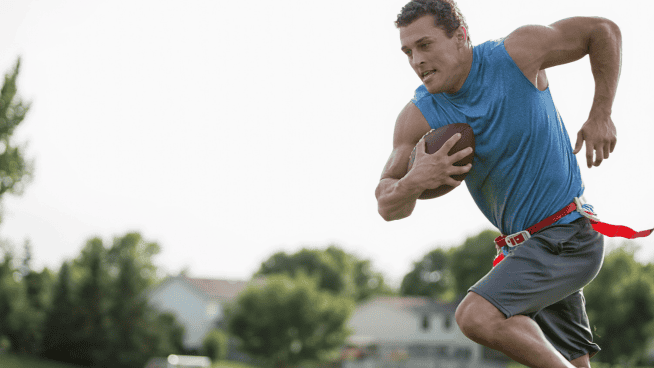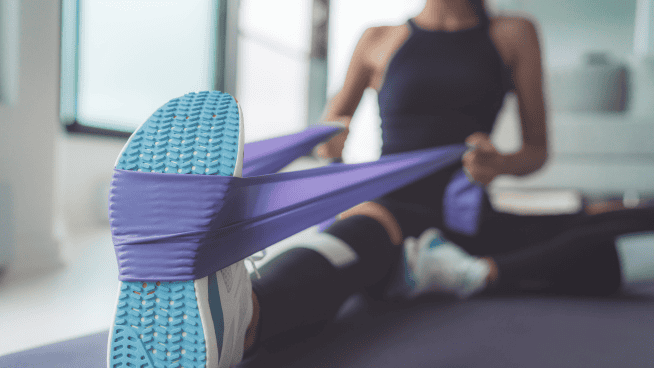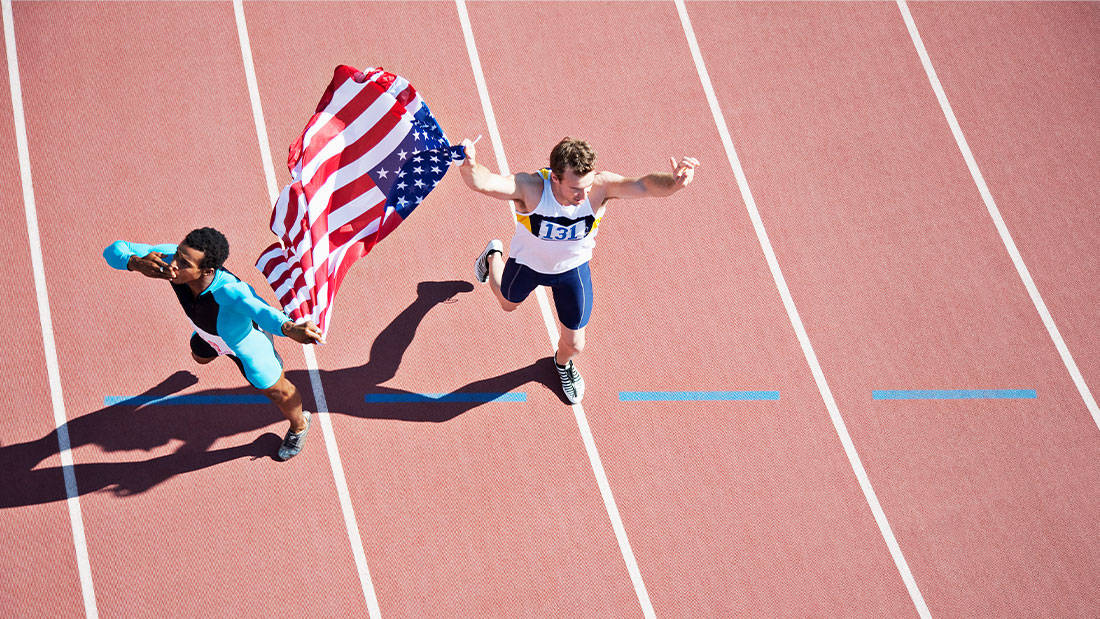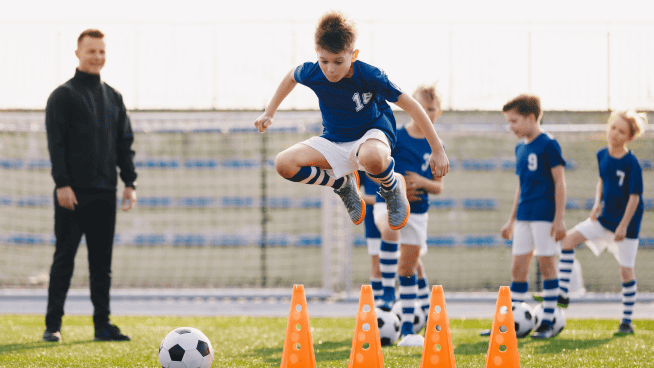The Soccer Weight Training Plan
A single visit to Williams Soccer Performance Systems shatters the notion that soccer players are meant to be scrawny, glorified distance runners. Inside this New Jersey-based facility, you see strong, wiry players straining under tremendous weights and exploding with amazing force. When you’re ready to break out of the old soccer mold, see what Mark Williams’ soccer weight training can do for your pitch performance.
“A lot of soccer players are out there doing circuit training with higher reps to build the strength endurance component of their conditioning,” says Williams, who has developed countless soccer strength training plans for world-class professional and collegiate players. “But those light weights and tons of reps don’t get you ready to be out on the field. I am more into the development of speed and power in the weight room. After all, speed is strength. You can do speed training until you’re blue in the face, but you won’t get faster without getting stronger”
The process through which heavy weights develop speed is downright scientific—and a little mental. “Studies show that the central nervous system is stimulated more as the weight you use gets heavier,” Williams says. “You hear about people in car accidents who are trapped under a car, and they get the superhuman strength to move the car off them. Training with heavy weights is like that; it’s like an alarm for your body. Your body knows it has to lift this heavy weight, and no one is there to help. It knows that it has to use as much muscle as possible to move the weight, or it will get crushed. This tells your nervous system to recruit more muscle fiber with an incredible force.”
As Williams’ athletes become as strong as possible relative to their body weight, they can apply more force into the ground when sprinting—the main determinant of speed. To ensure that the applied force is at its maximum, Williams’ athletes produce as much bar speed as possible in the concentric phase of each lift. “We are really tapping into pure fast twitch fibers when we move a bar that has 90 percent or more of our max quickly,” Williams says. “The faster you explode up on these lifts, the more muscle you use.”
If you’re still unsure about introducing massive loads into your soccer strength training plan, check out Williams’ client list; the success his athletes have enjoyed does the talking. “Tim Howard is my number one guy,” Williams says. “He is one of the best athletes I have ever worked with. He was so receptive to this training.” Howard, now the goaltender for Manchester United, worked out in Jersey during his MLS days, until he left for England. U.S. stars Eddie Pope and Clint Mathis have also elevated their games with the guru’s help.
Make sure to keep your excitement in check when tapping into Williams’ methods; you need to work up to heavy weights. “There is a training progression involved with this sort of lifting,” Williams says. “I am not going to throw a kid under the bar and have him do heavy weight and low reps right away. Once we overcome their weaknesses, then we start challenging them with heavier weight. Correct form is also very important—we never sacrifice that.”
Perform one lift from each category up to twice a week. Change up the exercises in your soccer weight training routine every two weeks.
Soccer Weight Training
Double-Leg Movements
Benefits: Explosive power, absolute strength and core strength
Williams: These movements develop explosive power by forcing you to overcome a pure static position. When you are on the box or pulling the bar from the floor on the deadlift, you have to overcome inertia to get the bar moving. This develops the starting strength and absolute strength all athletes look for. The faster you push or pull the bar, the more muscle fiber you recruit.
1. Box Squat
• Hold bar on back in athletic stance with feet just wider than hip-width and toes pointing slightly out
• Keeping weight back on heels, initiate movement by driving hips back
• Squat down with control and good posture until butt touches box and tops of thighs are parallel to floor; keep knees behind toes
• Explode up and out of squat position, keeping eyes up and chest out
Sets/Reps/Intensity: 1×8 at 25%; 1×5 at 50%; 1×3 at 62%; 1×1 at 73%; 1×1 at 90%; 1×1 at 100%; and 1×1 at 103%
2. Deadlift
• Grip bar just outside athletic stance with shins touching bar
• Assume deadlift position with back locked, shoulders up, and abs and chest flexed
• Explode up into standing position by extending hips and knees while keeping back flat and chest up
• Lower bar to floor through same motion; repeat
Sets/Reps/Intensity: 1×8 at 25%; 1×5 at 50%; 1×3 at 62%; 1×1 at 73%; 1×1 at 90%; 1×1 at 100%; and 1×1 at 103%
Note: Williams prefers using a Trap Bar Deadlift, because it provides a more natural line of movement. If you lack access to a trap bar, use a straight bar, but strictly adhere to the guidelines above. Make sure you don’t add substantial weight until your lower back is strong enough
Single-Leg Movements
Benefits: Strength, balance, kicking power, hip flexor strength and flexibility
Williams: These are some of the greatest exercises you can do for kicking power. They load the back hip flexor, and your quad goes through the same mechanics it does when you strike a soccer ball. This increases the flexibility and strength of your hip flexors, which has been shown in studies to improve speed. Soccer players are notorious for suffering from tight hip flexors.
1. Split-Squat
• With bar on back, assume shoulder-width, split stance with one foot in front of other
• Lower until back knee is just above floor
• Drive up into start position; repeat for specified reps
• Perform set on opposite side
Sets/Reps: 3×6-12 each leg
2. Single-Leg Squat
• Standing with bar on back, rest one foot on bench or box behind you
• Keeping chest up and front knee behind toes, lower into squat position until top of front thigh is parallel to floor
• Drive up into start position; repeat for specified reps
• Perform set on opposite side
Sets/Reps: 3×6-12 each leg
Glutes, Hamstring and Lower Back
Benefits: Lower back, core, glute and hamstring strength
Williams: I never have my athletes isolate their hamstring muscles; we always work them in conjunction with the low back and glutes. All of my hamstring exercises involve the hips because that’s how they are used.
1. Goodmornings
• With bar on back, assume athletic stance with slight bend in knees and feet at hip width
• Without changing flex in knees or spine position, bend forward at waist, then drive hips back until chest is almost parallel to floor
• Return to start position through same motion
Sets/Reps: 3×8-12
2. Reverse Hyper
• Position torso facedown on high box, table or Reverse Hyper Machine, so waist is at edge of surface
• Allow legs to hang toward ground, and grip sides of surface or machine’s handles
• Keeping legs straight, raise them until body forms straight line; pause
• Lower legs with control; repeat
Sets/Reps: 3×8-12
Photo: crossfit714.com
RECOMMENDED FOR YOU
MOST POPULAR
The Soccer Weight Training Plan
A single visit to Williams Soccer Performance Systems shatters the notion that soccer players are meant to be scrawny, glorified distance runners. Inside this New Jersey-based facility, you see strong, wiry players straining under tremendous weights and exploding with amazing force. When you’re ready to break out of the old soccer mold, see what Mark Williams’ soccer weight training can do for your pitch performance.
“A lot of soccer players are out there doing circuit training with higher reps to build the strength endurance component of their conditioning,” says Williams, who has developed countless soccer strength training plans for world-class professional and collegiate players. “But those light weights and tons of reps don’t get you ready to be out on the field. I am more into the development of speed and power in the weight room. After all, speed is strength. You can do speed training until you’re blue in the face, but you won’t get faster without getting stronger”
The process through which heavy weights develop speed is downright scientific—and a little mental. “Studies show that the central nervous system is stimulated more as the weight you use gets heavier,” Williams says. “You hear about people in car accidents who are trapped under a car, and they get the superhuman strength to move the car off them. Training with heavy weights is like that; it’s like an alarm for your body. Your body knows it has to lift this heavy weight, and no one is there to help. It knows that it has to use as much muscle as possible to move the weight, or it will get crushed. This tells your nervous system to recruit more muscle fiber with an incredible force.”
As Williams’ athletes become as strong as possible relative to their body weight, they can apply more force into the ground when sprinting—the main determinant of speed. To ensure that the applied force is at its maximum, Williams’ athletes produce as much bar speed as possible in the concentric phase of each lift. “We are really tapping into pure fast twitch fibers when we move a bar that has 90 percent or more of our max quickly,” Williams says. “The faster you explode up on these lifts, the more muscle you use.”
If you’re still unsure about introducing massive loads into your soccer strength training plan, check out Williams’ client list; the success his athletes have enjoyed does the talking. “Tim Howard is my number one guy,” Williams says. “He is one of the best athletes I have ever worked with. He was so receptive to this training.” Howard, now the goaltender for Manchester United, worked out in Jersey during his MLS days, until he left for England. U.S. stars Eddie Pope and Clint Mathis have also elevated their games with the guru’s help.
Make sure to keep your excitement in check when tapping into Williams’ methods; you need to work up to heavy weights. “There is a training progression involved with this sort of lifting,” Williams says. “I am not going to throw a kid under the bar and have him do heavy weight and low reps right away. Once we overcome their weaknesses, then we start challenging them with heavier weight. Correct form is also very important—we never sacrifice that.”
Perform one lift from each category up to twice a week. Change up the exercises in your soccer weight training routine every two weeks.
Soccer Weight Training
Double-Leg Movements
Benefits: Explosive power, absolute strength and core strength
Williams: These movements develop explosive power by forcing you to overcome a pure static position. When you are on the box or pulling the bar from the floor on the deadlift, you have to overcome inertia to get the bar moving. This develops the starting strength and absolute strength all athletes look for. The faster you push or pull the bar, the more muscle fiber you recruit.
1. Box Squat
• Hold bar on back in athletic stance with feet just wider than hip-width and toes pointing slightly out
• Keeping weight back on heels, initiate movement by driving hips back
• Squat down with control and good posture until butt touches box and tops of thighs are parallel to floor; keep knees behind toes
• Explode up and out of squat position, keeping eyes up and chest out
Sets/Reps/Intensity: 1×8 at 25%; 1×5 at 50%; 1×3 at 62%; 1×1 at 73%; 1×1 at 90%; 1×1 at 100%; and 1×1 at 103%
2. Deadlift
• Grip bar just outside athletic stance with shins touching bar
• Assume deadlift position with back locked, shoulders up, and abs and chest flexed
• Explode up into standing position by extending hips and knees while keeping back flat and chest up
• Lower bar to floor through same motion; repeat
Sets/Reps/Intensity: 1×8 at 25%; 1×5 at 50%; 1×3 at 62%; 1×1 at 73%; 1×1 at 90%; 1×1 at 100%; and 1×1 at 103%
Note: Williams prefers using a Trap Bar Deadlift, because it provides a more natural line of movement. If you lack access to a trap bar, use a straight bar, but strictly adhere to the guidelines above. Make sure you don’t add substantial weight until your lower back is strong enough
Single-Leg Movements
Benefits: Strength, balance, kicking power, hip flexor strength and flexibility
Williams: These are some of the greatest exercises you can do for kicking power. They load the back hip flexor, and your quad goes through the same mechanics it does when you strike a soccer ball. This increases the flexibility and strength of your hip flexors, which has been shown in studies to improve speed. Soccer players are notorious for suffering from tight hip flexors.
1. Split-Squat
• With bar on back, assume shoulder-width, split stance with one foot in front of other
• Lower until back knee is just above floor
• Drive up into start position; repeat for specified reps
• Perform set on opposite side
Sets/Reps: 3×6-12 each leg
2. Single-Leg Squat
• Standing with bar on back, rest one foot on bench or box behind you
• Keeping chest up and front knee behind toes, lower into squat position until top of front thigh is parallel to floor
• Drive up into start position; repeat for specified reps
• Perform set on opposite side
Sets/Reps: 3×6-12 each leg
Glutes, Hamstring and Lower Back
Benefits: Lower back, core, glute and hamstring strength
Williams: I never have my athletes isolate their hamstring muscles; we always work them in conjunction with the low back and glutes. All of my hamstring exercises involve the hips because that’s how they are used.
1. Goodmornings
• With bar on back, assume athletic stance with slight bend in knees and feet at hip width
• Without changing flex in knees or spine position, bend forward at waist, then drive hips back until chest is almost parallel to floor
• Return to start position through same motion
Sets/Reps: 3×8-12
2. Reverse Hyper
• Position torso facedown on high box, table or Reverse Hyper Machine, so waist is at edge of surface
• Allow legs to hang toward ground, and grip sides of surface or machine’s handles
• Keeping legs straight, raise them until body forms straight line; pause
• Lower legs with control; repeat
Sets/Reps: 3×8-12
Photo: crossfit714.com











